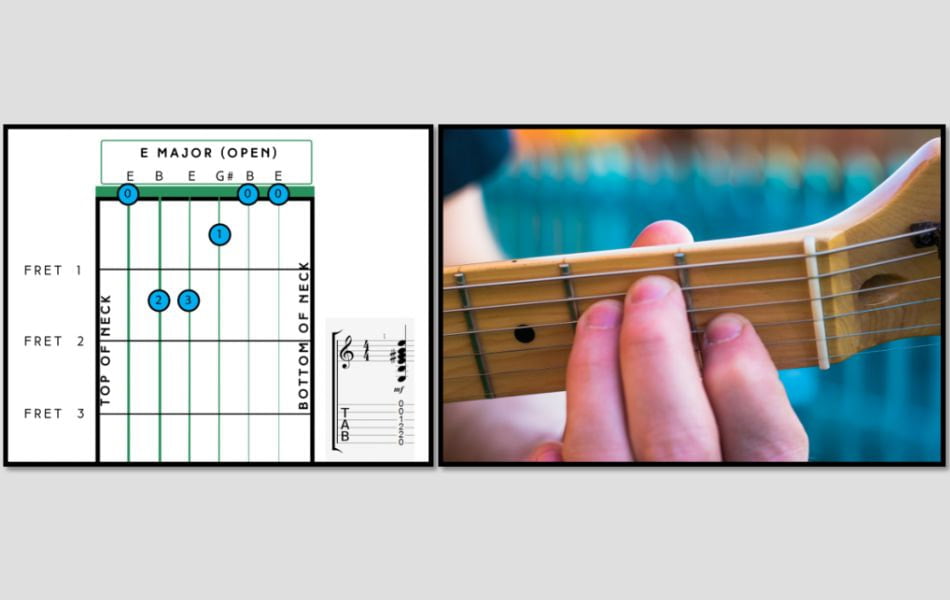Open E tuning guitar chords are indeed familiar to many guitarists and can significantly enhance your sound. Whether you’re a beginner or an experienced player, understanding and mastering Open E tuning is crucial to expanding your musical repertoire. In this guide, we will explore the basic chords and techniques for playing in Open E tuning, helping you unlock the full potential of this unique and exciting tuning.
Contents
What is open E tuning guitar chords
Open E tuning is a certain guitar tuning in which the strings are set up so that when the guitar is played openly (without pressing any frets). From the lowest (thickest) string to the highest (thinnest), the six strings of Open E tuning are tuned to the following pitches:
- 6th string (Low E): E
- 5th string: B
- 4th string: E
- 3rd string: G#
- 2nd string: B
- 1st string (High E): E
An major open E tuning guitar chords are automatically produced when you strum the guitar without fretting any notes. By just strumming all the open strings together, you can play an E major chord.
The adaptability of Open E tuning for slide guitar playing is one of its main benefits. Open strings produce a rich, resonant tone that combines nicely with slide playing. You can easily move a slide (a metal or glass tube placed over the strings) up and down the fretboard to create mellow, expressive melodies and chords while using a slide.
By positioning the slide at various frets and combining them, you can play a number of other chords in Open E tuning in addition to the E major chord. You may play a wide variety of chords in open E tuning with the slide and open strings.

How to strum the open E tuning chords
Open 6th string (Low E): Check if it sounds muted. Adjust your 2nd finger if it’s accidentally touching the string.
5th string (B): Ensure your finger is as close to the fret as possible and press down firmly for a clear sound. Make sure your 3rd finger isn’t touching the 5th string and muting it.
4th string (E): Play with your 3rd finger and place it close to the fret without touching it. Avoid muting by keeping your 1st finger from resting against the 4th string.
3rd string (G#): Place your 1st finger as close to the fret as possible. Use the tips of your fingers to avoid touching other strings.
2nd and 1st strings (B and High E): Play these strings open (without fretting any notes). Check that your 1st finger is not touching the 2nd string, which could affect its sound.
Following these instructions can help ensure that each string sounds clear when playing chords in Open E tuning on the guitar. Proper finger placement and attention to muting are essential for achieving clean and resonant chord sounds in this unique tuning.
Open Chords in Open E Tuning
In Open E tuning, several open chords can be played using the open strings and finger positions on the fretboard.
E Major: Open E tuning guitar chords
E Major chord is one of the fundamental open chords that you can play using the open strings and finger positions on the fretboard. So, follow these steps to play the E Major chord in Open E tuning:
- Start by playing the open 6th string (Low E) without pressing down any frets.
- Play the open 5th string (B) without pressing down any frets.
- Use your 1st finger to press down the 2nd fret on the 3rd string (G#).
- Use your 2nd finger to press down the 2nd fret on the 4th string (E).
- Use your 3rd finger to press down the 2nd fret on the 5th string (B).
- Play the open 1st string (High E) without pressing down any frets.
By strumming all the strings starting from the 6th string (Low E) to the 1st string (High E), you’ll produce the E Major chord. The open strings in this tuning naturally create the E major triad (E-G#-B), giving the chord its characteristic bright and uplifting sound.
The E Major chord is a foundational chord in music and is widely used in various genres, ranging from folk and country to rock and pop. In Open E tuning, the E Major chord becomes particularly powerful for slide guitar playing, as the open strings and slide technique combine to create a resonant and expressive sound.
Barre Chords in Open E Tuning
Once you have your fingers in position, strum all the strings from the 6th string (Low E) to the 1st string (High E). This will produce the E Major chord, as the notes E-G#-B are sounded together. The index finger’s barre across the 1st fret ensures that the notes on the other strings are fretted correctly to form the full chord.
Barre chords in Open E tuning guitar chords offer the flexibility to play various chords by moving the same shape up and down the fretboard.
- Start by using your index finger to press down all the strings on the 1st fret like a barre. And ensure that your index finger lays flat across all the strings to fret them simultaneously.
- Place your 2nd finger on the 2nd fret of the 3rd string (G#). This creates the note G#, which is the major third of the E major chord.
- Position your 3rd finger on the 4th fret of the 4th string (E). This note is the root of the E major chord.

In conclusion, open E tuning guitar chords and its power to elevate your guitar playing to new heights. A universe of intriguing tones and musical expressions is available in open E tuning.
